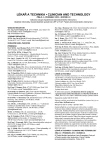Modelling of Cardiovascular System Regulation
Authors:
Stefan Borik; Ivo Cap
Authors‘ workplace:
Department of Electromagnetic and Biomedical Engineering, University of Zilina
Published in:
Lékař a technika - Clinician and Technology No. 4, 2013, 43, 18-22
Category:
Original research
Overview
The article deals with principles of cardiovascular system regulation. The work describes physiological basis of selected regulation mechanisms such as autoregulation and baroregulation. An overview of cardiovascular system models is presented. The paper contains description of linear regulation models and also models containing nonlinear phenomenon. The article describes implementation of heart rate and vascular resistance regulation to existing model of arterial system based on the principle of electromechanical analogy. The implemented regulation model is based on baroreceptor regulation application. There are analysed characteristic properties of baroreceptor regulation such as saturation, hysteresis or step change in baroreceptor impulse rate.
Keywords:
Baroreceptor, cardiovascular system, heart rate, modelling, regulation, vascular resistance
Sources
[1] MURRAY, Cecil D. The physiological principle of minimum work: I. The vascular system and the cost of blood volume. Proceedings of the National Academy of Sciences of the United States of America, 1926, 12.3 : 207.
[2] MURRAY, Cecil D. A relationship between circumference and weight in trees and its bearing on branching angles. The Journal of General Physiology, 1927, 10.5 : 725-729.
[3] GUYTON, Arthur C.; COLEMAN, Thomas G.; GRANGER, Harris J. Circulation: overall regulation. Annual review of physiology, 1972, 34.1 : 13-44.
[4] WARNER, HOMER R. The frequency-dependent nature of blood pressure regulation by the carotid sinus studied with an electric analog. Circulation Research, 1958, 6.1 : 35-40.
[5] TAHER, Mona F., et al. Baroreceptor responses derived from a fundamental concept. Annals of biomedical engineering, 1988, 16.5 : 429-443.
[6] OTTESEN, Johnny T.; OLUFSEN, Mette S.; LARSEN, Jesper K. Applied mathematical models in human physiology. Philadelphia: Society for Industrial and Applied Mathematics, 2004.
[7] KEENER, James P.; SNEYD, James. Mathematical physiology. Springer, 1998.
[8] JAVORKA, K., et al. Lekárska fyziológia. Osveta, Martin, 2001.
[9] HALL, John E. Guyton and Hall Textbook of Medical Physiology: Enhanced E-book. Saunders, 2010.
[10] KOFRÁNEK, Jiří; RUSZ, Jan; MATOUŠEK, Stanislav. Guytons diagram brought to life-from graphic chart to simulation model for teaching physiology. Technical Computing Prague, 2007, 1-13.
[11] CZIPPELOVA, B.; GOMBARSKA, D. The wave analysis of terminal segment effect on blood pressure and blood flow propagation. In: Proc. of 8th international conference KRALIKY 2010. 2010. p. 32-35.
[12] CAP, Ivo; CZIPPELOVA, Barbora. Electromechanical Model of Blood Flow in Vessels. Advances in Electrical and Electronic Engineering, 2011, 7.1-2 : 338-341.
[13] ČÁP, Ivo, et al. Modelling of the blood flow and pressure waves reflections in vessels. International Journal of Applied Electromagnetics and Mechanics, 2012, 39.1 : 501-506.
[14] GOMBARSKA, D.; CZIPPELOVA, B. Computer simulation of human cardiovascular system. Acta Technica. 2012, Vol. 57, No. 4, p. 407-420.
[15] GOMBARSKA, D.; CZIPPELOVA, B. Modelling of arterial bifurcation by means of electromechanical model with distributed parameters. BIOMEDICAL TECHNOLOGY–2011 AND BEYOND, 22.
Labels
BiomedicineArticle was published in
The Clinician and Technology Journal

2013 Issue 4
Most read in this issue
- Vývojové poruchy zubů a jejich diagnostika pomocí rentgenových snímků
- Metodika merania na celotelovom 3D skenery a možnosti aplikácie
- Termografické hodnocení radiofrekvenční ablace stentů ex vivo
- Utilizing of MEMS sensors in rehabilitation process
